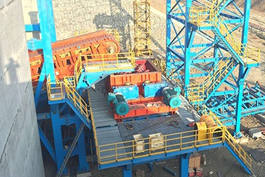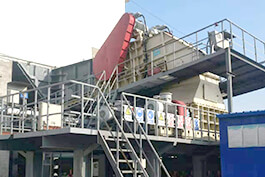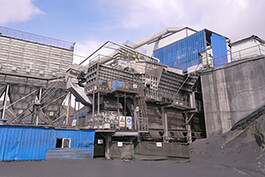Types of lubrication systems used in Mineral sizer
Thick oil lubrication system
Working principle
This system uses lubricating oil as the lubricating medium. The oil pump sucks the lubricating oil from the oil tank, and after filtration and cooling, it is transported through pipelines to various lubrication points of the Mineral sizer, such as the bearing parts. The lubricating oil forms an oil film at the lubrication points, reducing friction, lowering wear, and dissipating heat. Subsequently, the lubricating oil, under the influence of gravity or through the return pump, flows back to the oil tank, thus completing the entire cycle process successfully.
Advantages
This thin lubricating oil has excellent fluidity and heat dissipation performance, which can effectively remove the heat generated by friction and ensure that the working temperature of components such as bearings remains within a reasonable range, thereby extending the service life of the equipment. Moreover, this thin oil lubrication system can achieve precise lubrication, providing significant protection for the key components of the mineral sizer and effectively reducing the risk of mineral sizer failure, improving the reliability and stability of equipment operation.
Application scenarios
Suitable for lubricating high-speed rotating components in the mineral sizer, such as the bearings of two crushing tooth rollers. These parts have extremely high rotational speeds during equipment operation and generate a large amount of heat. The excellent heat dissipation performance of the thin oil lubrication system can meet their operational requirements.
Grease lubrication system
Working principle
The grease lubrication system is generally composed of a grease station, distributor, pipelines, etc. The grease station extracts the grease by applying pressure, and then the distributor evenly distributes the grease to each lubrication point according to a specific ratio. At the lubrication points, the grease forms a layer of oil film with excellent adhesion and waterproof properties, effectively achieving both lubrication and protection functions.
Advantages
The dry oil lubrication system has a simple structure, is easy to maintain, has strong adhesion to the lubricating grease, and is less prone to leakage. This system can provide reliable lubrication protection for mineral size sorters operating in dusty and humid environments. Moreover, dry oil lubrication does not require complex cooling and filtration devices, and is more cost-effective.
Application scenario
Suitable for low-speed high-load components of mineral sizers, such as the shaft neck area between the gear drum and the bearing housing. These components are subjected to tremendous pressure, and the high load-bearing performance of dry lubricating grease can fully meet their lubrication requirements, thereby ensuring the stable operation of mineral sizers.
.jpg)
The role of the grease pump in the Mineral sizer
Reduce wear
During the operation of the Mineral sizer, there will be frequent and intense relative movements between the double toothed rollers and between them and other components. The grease pump continuously and stably supplies grease to these critical areas, forming an oil film on the surface of the components, effectively reducing direct contact between metals and thereby reducing friction wear and significantly extending the service life of the equipment. For example, if the grease supply is insufficient, the tooth tips of the toothed rollers may deform due to excessive wear in a short period of time, which may affect the crushing effect; while proper lubrication can significantly slow down the wear rate of the tooth tips.
Ensuring operational stability
A reliable grease pump ensures that grease is accurately supplied to each lubrication point at the set flow rate and pressure, maintaining the normal operation of all components of the equipment. If the grease pump malfunctions, such as unstable flow, it may lead to poor lubrication in some areas, causing vibration and abnormal noise. In severe cases, it may even cause the rotation of the double-toothed rollers to become stuck, affecting the continuity and stability of the crushing operation.
Improving heat dissipation efficiency
During the crushing process, the friction between components generates a large amount of heat. The lubricating grease can absorb some of this heat during its flow, playing a certain role in heat dissipation. The grease pump can ensure the circulation of the grease, allowing heat to be dissipated in time, thereby preventing the mineral sizer from being damaged due to overheating. During continuous high-intensity crushing operations, if the heat dissipation is not timely, the temperature of the gear rollers may become too high, which may subsequently alter their physical properties and affect the accuracy of the crushing process. However, a good lubricating grease circulation can effectively prevent this from happening.
Selection of Lubricating Grease Pumps
Manual grease pump
Simple in structure and low in cost. Suitable for small Mineral sizer crushers or situations with fewer lubrication points and intermittent equipment operation. Operators can squeeze the grease out by manually pressing or rotating and deliver it to the lubrication areas. However, manual operation is difficult to ensure the accuracy and timeliness of lubrication, and it is prone to problems such as insufficient or excessive lubrication. For example, in small mining enterprises, if the Mineral sizer crusher operates at a low frequency and has a limited budget, a manual grease pump can be an economical choice.
Electric lubrication pump
Driven by electricity, it can automatically supply lubricating grease at the preset time intervals and fixed quantities. It can be precisely adjusted according to the operating parameters of the equipment and the lubrication requirements to ensure the stability and reliability of lubrication. This equipment is particularly suitable for situations with high work intensity and strict lubrication requirements. For example, in large stone processing plants, the electric lubrication pump can ensure that the components of mineral sizers receive sufficient lubrication during long-term high-load operation, thereby improving production efficiency and equipment reliability.
Pneumatic grease pump
Powered by compressed air, it boasts significant advantages such as high output pressure and large flow rate. It is particularly suitable for harsh working environments, such as dusty and humid Mineral sizer operations. By using compressed air for drive, it demonstrates greater adaptability in such environments, effectively preventing electrical components from being damaged due to dust and moisture erosion. For instance, in the crushing workshop of an open-pit coal mine, the pneumatic grease pump can operate stably, providing reliable lubrication for the Mineral sizer.
Installation and Maintenance of Grease Pumps
Installation Location
It is important to pick an installation location that is easy to operate and maintain and close to the lubrication point. Install firmly to avoid loosening, taking into account vibration and impact during machine operation. In order to avoid damaging the pump body or impairing the grease's effectiveness, do not install in locations that are susceptible to material splashing or high-temperature baking. The grease pump in our mineral sizer is positioned in the middle, between the two driving devices, making it easy to connect to different lubrication locations and to make it easier for operators to perform daily inspections and maintenance.
Pipeline Connection
To guarantee efficient grease transmission, the pipeline should be constructed of the right materials and have the right diameter. To stop leaks, the connection parts need to be tightly sealed. To lessen flow resistance, the pipeline should be as short as possible in bends. To prevent blockage during installation, the pipeline should be cleaned and blasted to remove pollutants.
Daily Upkpee
Check the grease pump's operation on a regular basis, paying particular attention to the motor or pneumatic components' operation, pressure, and flow rate. Verify the grease's level and quality, and replace any degraded grease as soon as possible. To stop dust and debris from getting inside the pump or obstructing the pipeline, clean the pump body and pipeline surface.
Fault Diagnosis
Common issues include a grease pump that doesn't pump grease can be brought on by motor failure, suction port filter screen obstruction, or pump blockage. Prior to checking for foreign items in the pump, make sure the suction port is clear and the filter screen is clean. Examine the power source, motor winding, etc. if the motor is not rotating. Check for damage to the sealing components and replace them as soon as possible if there is a grease leak. Consult the equipment handbook or get in touch with qualified maintenance staff to handle complex issues.


.jpg)
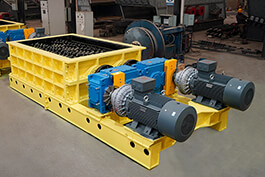
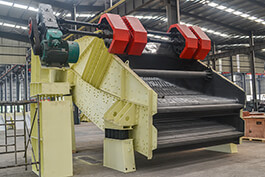
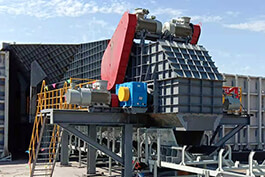
.jpg)
